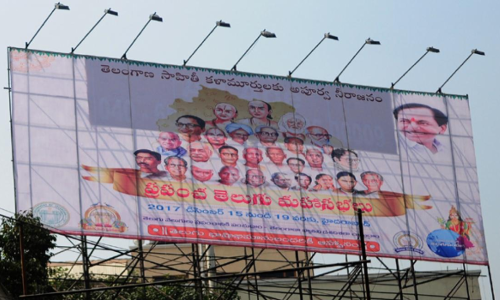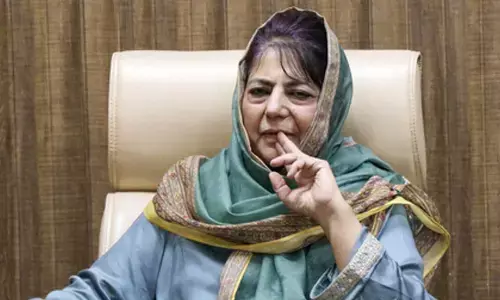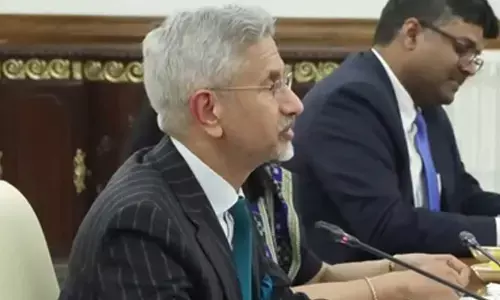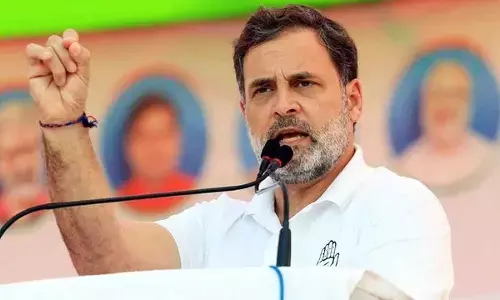The glory of language & literature

The Telugu language, that now has an official classical status, began developing even from the pre-Nannaya times (pre 1020 AD). The existence of prose right from the 6th century AD has been corroborated by epigraphic evidences.
On the eve of the 5-day World Telugu Conference in Hyderabad scheduled from Dec 15 to 19, let us take a quick ramble across a desultory time-frame for a broad survey of the evolution of the Telugu language cum literature, and in the welcome background of the realisation, on the part of the two Telugu states, of the importance of making its study mandatory in the school education and ensconcing it on a pedestal of right prominence in every sphere of activity.
The Telugu language, that now has an official classical status, began developing even from the pre-Nannaya times (pre 1020 AD). The existence of prose right from the 6th century AD has been corroborated by epigraphic evidences. According to the eminent researcher Veturi Prabhakara Sastry, the word ‘Naagabu’ in the Brahmi script on the Amaravati sthoopa of 200 AD is a Telugu term. It derived from the Sanskrit ‘Naaga’. There are Telugu words even in Hala’s Gatha Saptasati which is in Prakrita.
The custom of inscriptions in Telugu was initiated by the Renati Cholas. In circa 550 AD they granted temples to the Brahmins in Rayalaseema, sealing the details by way of inscriptions. In the inscription by Pandaranga, the general of Gunaga Vijayaditya, there is a poem in the Taruvoja meter besides matter in prose. This was in 848 AD during the period of the Eastern Chalukya kings. Later on in the epigraph installed by Chalukya Bhima in the Koravi village of Mahabubabad Taluk, we find dialogic sentences as well as narrative style. Thus a language suitable for long poetic works had taken shape.
Telugu language was in an amorphous state in 9th century AD, and it was left to Nannaya (1022-1063) to bring order and beauty to it. A polyglot, well-versed in Telugu, Sanskrit, Prakrita and Kannada, he directed the language into an optimal form, and was therefore honoured as Vag-Anusasana. It is well known that he began the translation of Vyasa’s Mahabharata but could complete only the Adi and Sabha Parvas and half of the AranyaParva.
It took two centuries thereafter for the unfinished task to be resumed by Tikkana Somayaji (1205-1288), chief minister of Manuma Siddhi, the Choda king, who ruled the Nellore kingdom. He succeeded in translating the phenomenal portion of as many as fifteen books (parvas). The half-done third book (AranyaParva) had to hibernate until circa 1330 AD when it fell to the lot of Errapragada to complete it, to make the Andhra Mahabharata a wholesome unit. From then on Nannaya-Tikkana-Errana have acquired the epithet Kavi Trayam, the Poetic Trinity to whom the World Telugu Conference has allotted an arch (Toranam No. 46).
In the background of the present two Telugu states, it would be interesting to know that soon after Manumasiddhi was crowned, he was driven away by his cousin Vijayaditya. Tikkana travelled to Orugallu (Warangal) and sought the help of Ganapati Deva, the Kakatiya King (1199–1262) who readily intervened and restored the kingdom to Manumasiddhi. This is evident from KaseSarvappa’sSiddheswaraCharitra.
The very mention of ‘Kakatiya’ stirs up many a chivalrous, artistic, literary and cultural memory. Jayapa Senani, the military chief under Ganapati Deva, wrote Nritya Ratnavali, a Sanskrit work dealing with the dance forms in the Telugu land.Prataparudra (1289-1323) had in his court great poets and scholars like Vidyanatha whose Alankara Sastra titled Pratapa-Rudriyamstill stands out as an authoritative text on Sanskrit poetic aesthetics. And its commentary by the great Mallinatha Suri (1346-1440)is unparalleled.
We had kings according to the times, religion according to the kings, and poetry according to the religion. As part of this literary evolution, we had a spell of two hundred years reigned by Saivite poets. Mallikarjuna Panditaradhya (1120-1180), a poet in the court of Chandavolu VelanatiChoda king, created many works in Sanskrit, Andhra and Karnataka languages. He chronicled the histories of Siva devotees in his Siva-Tattva-Saram which Palkuriki Somanatha called a Sataka. Sataka is a genre of poetic composition comprising one hundred or more stanzas, with a refrain, which seeks to instil moral or devotional values.
A polyglot, PalkurikiSomanatha was also well-versed in Sanskrit, Marathi and Kannada. A polymath, he mastered even music, dance, alchemy, and medicine. He penned dwipadas like Basava Purana and Panditaradhya Charitra, gadyas like Pancha- Prakara Gadya and Saranu Basava Gadya, and ragadas like Basava Ragada. While dwipadas are metrical couplets, gadya is musical prose, and ragada, as per CP Brown is a “melody similar to the descants or tirades (as they are termed) in French poetry.”Somana’s Anubhava Saram was a unique short poetic work, and he treated Mallikarjuna Panditaradhya as Lord Siva himself.
Nannechoda, considered the first Prabandha poet, wrote Kumara Sambhavam which is also a Saivite story wherein the marriage of Siva and Parvati for the sake of destruction of demon Taraka and the birth of Kumara Swamy to them are the main episodes. Nannechoda claimed that he wrote this work in Jaanu Tenugu, in a Telugu that has the least Sanskrit diction and can be easily understood by the commoners. While some critics predate Nanne Choda to Nannaya, others place him after Nannaya but before Tikkana.Nannechoda, Mallikarjuna Panditaradhya and Palkuriki Somanatha are knowns as Siva Kavi Trayam, the Saivite Poetic Trio.
The story of Rama has had a sublimeniche in the psyches and hearts of the Telugus. Conscious of this bond, a number of poets from the past to the present times have been delivering their own versions of Ramayana. Errapragadawrote a Telugu Ramayana and dedicated it to the then ruler Prolaya Vemareddy. Among the plethora of Telugu renditions of the Ramayana, those that have gained durable popularity are Ranganatha Ramayana by Gona Buddha Reddy, Uttara Ramayana by Kankanti Paparaju, Bhaskara Ramayana by HulakkiBhaskara, and Nirvachanottara Ramayana by Tikkana. While the Ramayana by Molla emits a jasmine-like fragrance, the modern times have given us the versions of ‘Andhra Valmiki’ Vavilikolanu Subbarao, and the Ramayana Kalpavriksham by Viswanatha Satyanarayana which earned him the Jnan Pith award.
The splendour of Srinatha (1365-1441), celebrated as the emperor of poets, is beyond description. He produced a number of poetic compositions like Hara Vilasam, Marut-Tarat Charitra, Bhima Khandam, Kasi Khandam and Sringara Naishadham. His chatuvulu, unpublished poems but passing down by word of mouth, are witty and humorous. Srinatha was a literary giant of his time. The chief education officer in the court of PedakomatiVemareddy, he had lived a pompous and luxurious life but his last days were eked out in utmost misery.
Bammera Potana (1450-1510) is one of the most popular poets. He translated Vyasa’s Sanskrit Bhagavatam into Telugu, and it became so popular that every village turned into a sort of Krishna’s birth place, and every villager turned into a Krishna devotee. Here, let us recall an interesting anecdote. A poor Brahmin approached CP Brown (1798-1884), a district collector and Telugu lexicographer and Telugu researcher, for financial help.
In his petition he quoted a poem from Potana’s Bhagavatam to highlight his misery: “I have lost all my strength; and shaken is all my courage.” In turn, Brown replied, “Give up the fear that you will die; meditate upon Lord Hari, and you will be released from the mortal coil,” quoting a poem from the same source. So deeply have Potana’s poems sunk into the psyche of the Telugus irrespective of their socioeconomic strata. Potana had also written Bhogini Dandakam, eulogising the courtesan of king Singa Bhupala, and VirabhadraVijayam about the Daksha yagna and its aftermath.
K Gopalakrishna Rao, under the guidance of Dr Divakarla Venkatavadhani, researched on the Sataka literature and brought out a book. It was only around that time that the Osmania University began encouraging doctoral research on Telugu language and literature. In his foreword to the book, Khandavalli Lakshmi Ranjanam says: “It is customary that only doctorates can guide one to a doctoral degree.
I don’t have a doctorate, yet I am permitted to guide the PhD students.” The first ever PhD in Telugu Literature from Osmania University was earned by Dr Biruduraju Ramaraju who researched on folk songs. By the way K Gopalakrishna Rao was also a master of Urdu literature. An authority on the influence of Arabic, Urdu and other non-Sanskrit languages and literatures on Telugu, he even compiled a Telugu-Urdu dictionary.
Though the genre of Sataka is there in Sanskrit, Prakrit and south Indian languages, it is much more prolific in Telugu, what with over nine thousand works, both published and unpublished, existing. Unlike the epic and mythological literature, Satakas in Telugu are not translations from Sanskrit; they are original compositions. The Sataka stanzas have such a mnemonic felicity and lyrical grace that they have been popular right from the kids to the grey hairs.
The seeds of the Sataka genre can be traced to the Rigveda, where in its third Mandala there are fourteen riks with the refrain ‘Sajanaah Indrah.’ It is Amritananda Yogi of the 12th century AD who first mentioned the word Sataka with reference to Telugu literature. Satakas are a treasure trove of things galore. There is a kaleidoscopic variety of Satakas in Telugu – didactic, humorous, satirical, and ironical.
There are Satakas dealing with even grammar and lexicons, as well as those focusing on a particular syllable, example ‘R’. A headache balm entered the head of Kari Narayanacharyulu and inspired him to reel off a hundred stanzas with the refrain ‘Amritanjanama’ (Oh, Amritanjan)! Irrespective of the ages, the Sataka literature has flowed like an undercurrent throughout, right from its origin down to the present times.
By Dr Dittakavi Syamala Devi & U AtreyaSarma
















